Podcast
Questions and Answers
What era does the jamb statue from the Reims Cathedral belong to?
What era does the jamb statue from the Reims Cathedral belong to?
- Romanesque
- Renaissance
- Baroque
- High Gothic (correct)
What material was primarily used for the jamb statue at Reims Cathedral?
What material was primarily used for the jamb statue at Reims Cathedral?
- Stone (correct)
- Bronze
- Wood
- Marble
Which figures are depicted in the jamb statue from Reims Cathedral?
Which figures are depicted in the jamb statue from Reims Cathedral?
- Angels with wings
- Women in flowing robes (correct)
- Historical kings
- Mythological creatures
In what geographical location is the Reims Cathedral found?
In what geographical location is the Reims Cathedral found?
Around what year was the jamb statue created?
Around what year was the jamb statue created?
Flashcards
What is the name of the sculpture?
What is the name of the sculpture?
The Visitation, detail of jamb statue from west facade, Reims Cathedral.
When was the Visitation sculpture created?
When was the Visitation sculpture created?
The sculpture was created around 1225-1245 A.D.
What is the style of the Visitation?
What is the style of the Visitation?
High Gothic.
What material is the Visitation made of?
What material is the Visitation made of?
Signup and view all the flashcards
Where is the Visitation located?
Where is the Visitation located?
Signup and view all the flashcards
Study Notes
The Visitation
- Title: The Visitation, detail of jamb statue from west facade, Reims Cathedral
- Date: ca. 1225-1245 A.D.
- Culture: French, High Gothic
- Medium/Material: Stone sculpture in high relief
- Location: Reims (Île-de-France), France
Studying That Suits You
Use AI to generate personalized quizzes and flashcards to suit your learning preferences.
Description
Test your knowledge on 'The Visitation', a detailed jamb statue from the west facade of Reims Cathedral, created between 1225-1245 A.D. Discover the significance of this French High Gothic sculpture and its intricate stone work. Explore its historical context and cultural impact.



